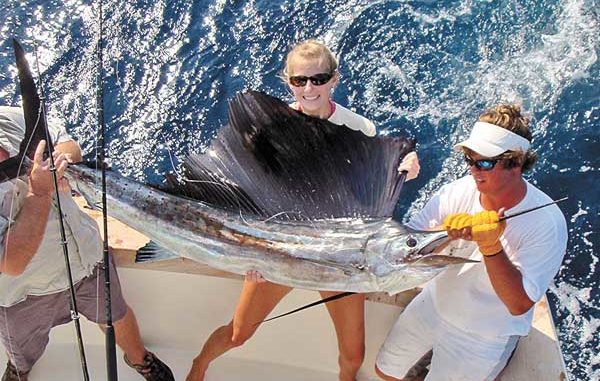
When can a fisherman rely on catching a sailfish off the coast of South Carolina? It seems that the answer is: in the fall.
A sailfish bite has blossomed the past five years, spawning a specialized tournament (the Sailfish Slam) and causing deer season and saltwater fishing to get crossed up.
Sailfish have become prominent off the coast during the summer, but the fall remains the best season for sheer numbers of hook-ups. It can be argued that the S.C. Governor’s Cup Billfishing Series, which takes place in June and July, has been won the past two years by boats targeting sailfish. In August, the sailfish were literally jumping along with the king mackerel in nearshore waters, allowing anglers in smaller boats a great shot at releasing a billfish.
But fall is when multiple shots at sailfish can really pile up, and the main reason for the concentration is bait. Sardines and other marine minnows gather in “bait balls” for protection, and they are neon “STOP” signs for predatory billfish. Other bait is scattered in the fall, but the bait balls stand out, easily located by standard marine electronics as well, leading them to promising sailfish spots.
In order to mimic bait balls, anglers will want to pull dredge rigs, which are simply teasers rigged with plastic baits or mullet — though not in the standard daisy chain. Place one of your flat lines behind the dredge rig, carrying something like a blue-and-white Islander rigged with a circle hook for the best shot at getting hooked up.
Circle hooks fish a little different than J-hooks, and offshore anglers are learning by a trial-and-error process. By and large, circle hooks are much better for the fish — hooking them in the mouth and not in the gut — but the process is a bit different. With J-hooks in use, reels are set to “strike,” and when a fish hits, the resistance on the line sets the hook. When a circle-hook is used, the angler puts the reel in free spool to dump line for about five seconds before easing in the drag system. No hook-set is required with circle hooks, and in fact, if you raise the rod tip too soon, it can make the sail jump before the hook finds the corner of its mouth, and he’ll spit the offering out.
But once fish are hooked up on circle hooks, they tend to stay hooked. When a sailfish starts grey-hounding or making its routine jumps, anglers rest easier with a circle hook holding the excited billfish to the business end of the line.
With the sailfish bite becoming more reliable, a number of anglers are picking up their first billfish releases via a sailfish encounter. Atlantic sailfish tend to run small, 50 pounds or less, making them well-suited for a duel with a youth or female angler. I have been on the transom on two occasions when anglers have caught and released their first sailfish — and it makes for a great way to promote the sport of saltwater fishing. Not to mention, a first sailfish is always accompanied by a dunk in the water once back at the docks — another rite of passage for outdoor enthusiasts.
One such fishing enthusiast is Lauren Dumas of Charleston, a schoolteacher who is getting serious about saltwater fishing. After starting out two years ago catching redfish, trout and sharks in inshore waters, she set her sights bit higher in 2009. She attended a flounder-fishing seminar at Haddrell’s Point tackle shop and set out to catch her first flounder. The seminar was held in May, and by June she was able to share a photo of her and a fine flat fish.
But what about offshore fishing? She said, “I want to go offshore fishing more than ever, and I want to catch a sailfish!”
The manager at Haddrell’s helped her get a ride on the Game Day, a Charleston-based sportfisher, and she had some great luck, catching and releasing a sailfish on her first trip. Capt. Bobby Kriv was able to put Dumas on the sailfish in early August, and she did her part by reeling in the sail — earning her a splashy celebration when they returned to port.
Isn’t there something else in October that involves big game — oh yes, deer season enters the rut. Fishermen targeting sailfish who also like to hunt deer are busy perfecting the sporting double-header of sailfishing in the morning, then climbing a tree stand in the afternoon — making for a perfect sporting day.
Sailfish tend to be closer to the coastline in the fall, making for a shorter run back and forth to the fishing grounds and allowing time to hit the deer woods later in the day. Releasing a sail in the morning, and then harvesting a deer in the evening sounds like a great way to celebrate our sporting heritage.



Be the first to comment